7Hz Timeless Review - All Aboard the Hype Train?
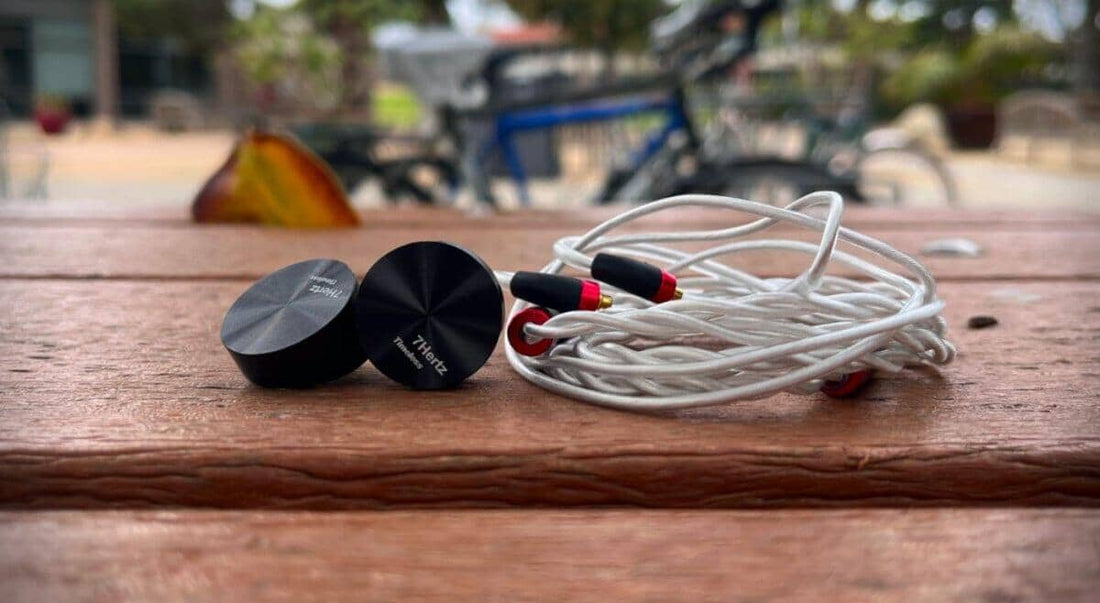
Introduction
There's a lot of variety when it comes to driver types in the IEM world, from dynamic drivers, BAs, ESTs, to piezo-electric tweeters. And of course planars. Planars are a staple in the headphone world, with headphones from manufacturers like Audeze and HiFiMAN reflecting as some of the best headphones the world has to offer. But when it comes to IEMs, the story is a bit different. And not in a good way. Suffice it to say that I have not been a fan of a single planar IEM that I have heard. At least in the case of technical marvels such as Audeze’s LCD-i4, the bottleneck seems to be tonal balance. This is where the 7Hz Timeless comes in, having been touted by the community as being something of a tuning marvel amongst planar IEMs and at a mere $220 no less. Read on to find out how the Timeless stacks up to my ears.
This unit was provided for review courtesy of Linsoul from which you can buy the Timeless here. Thank you! As always, what follows are my honest thoughts and opinions to the best of my ability.
Source & Drivability
All critical listening was done off of my iBasso DX300 and iPhone 13 Mini with lossless files. The stock cable and stock ear tips were used. The Timeless takes a moderate amount of power to drive, but no more than would be required of most single-DD IEMs. I found myself at ~ 30% volume on my iPhone to hit my usual listening levels of ~70dB.
The Tangibles
The Timeless arrives in a fairly small box with the following accessories inside:
- Aluminum case
- wide assortment of silicone tips
- MMCX cable
- Documents and QC card

I don’t like the case that comes with the Timeless. It’s milled out of solid aluminum with a magnetic latch, but something about it feels “off” to me. Maybe it’s the dried glue I can see leaking out from the felt lining inside. Maybe it was the grime smeared on the top of the case when it arrived, maybe it’s the chemical smell, maybe it’s the inconsistent machining. In all fairness, I don’t really expect good cases with a product like this, but this case could use some work.
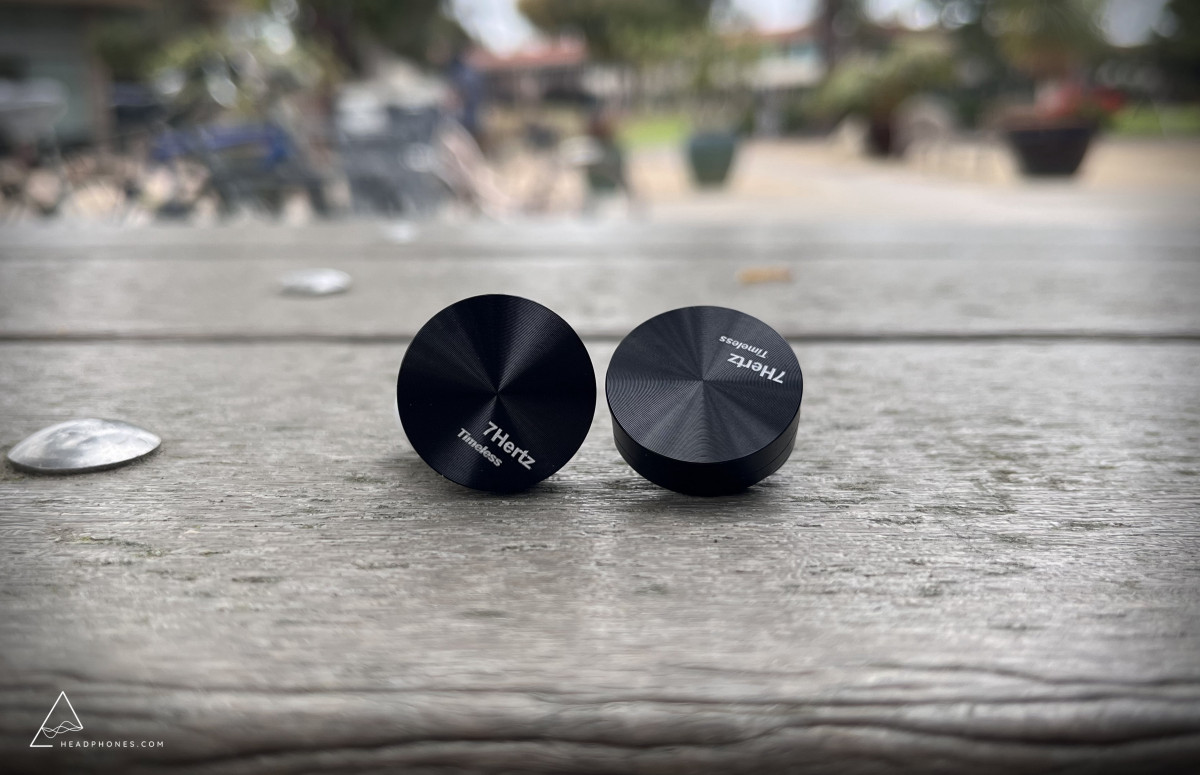
The Timeless itself has a circular, aluminum shell mated to a plastic frame. Despite the quality-control memes I've read about on some forums, I don't think this is a particularly poorly built IEM and close examination of the build didn't point out any issues. If you’re concerned about the fit of the Timeless, go grab a nickel and stick it in your ear - there's your fit test. Surprisingly, the Timeless actually sits pretty nicely - almost flush - in my ears. However, I found comfort to be more of a mixed bag, as I could feel the circular shells starting to dig in after a couple hours. As usual though, fit is 100% subjective and your mileage might vary!
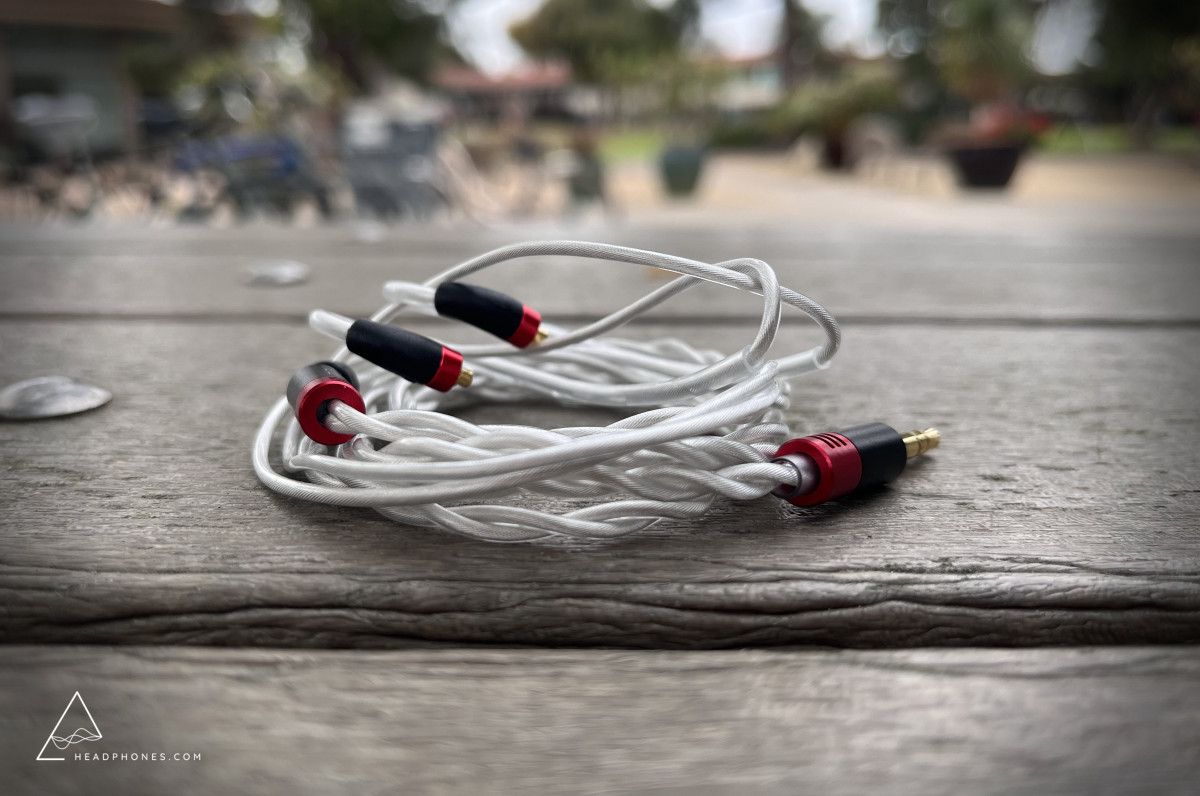
The cable of the Timeless is pretty nice in my opinion - at least as far as usability is concerned. It's fairly pliable, doesn't kink, and locks into place solidly via the MMCX connectors. There's even some slightly more complex machining that's gone into the 'vents' on the hardware. You won't see any complaints from me on this front.
Sound Analysis
The frequency response below was taken off of an IEC-711 coupler. There is a resonance peak at 8kHz, as such, measurements after this point should not be considered entirely accurate. You can visit this link to compare the Timeless to other IEMs that I have graphed.
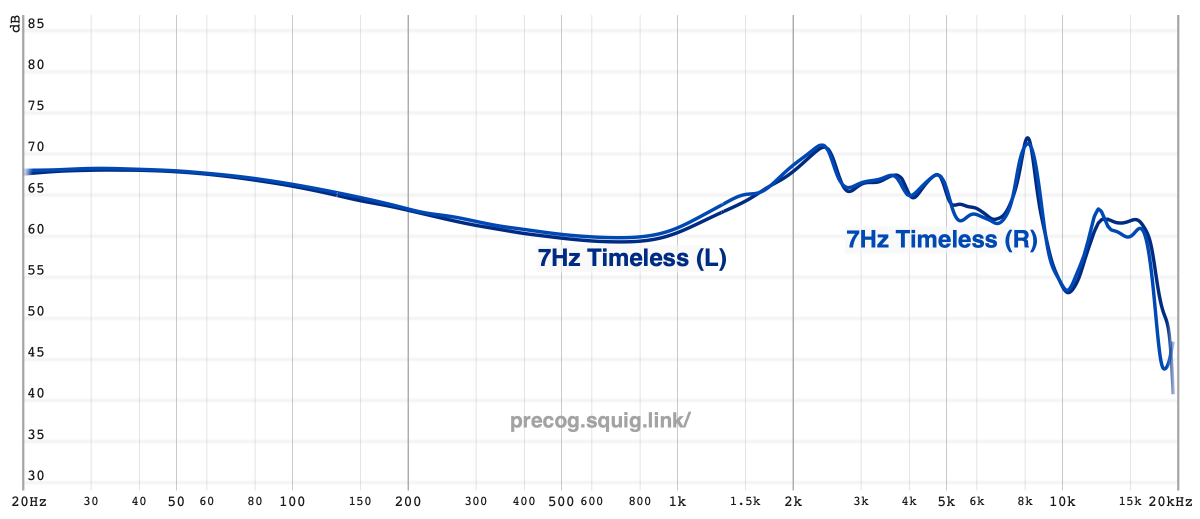
Here, the Timeless certainly makes its mark for actually being listenable straight out of the box (unlike most all other planar IEMs I've heard). But let there be no mistake: listenable tonality is no substitute for good tonality. To my ears, the tuning of the Timeless is simply chock full of minor issues, namely 1) the bass shelf, 2) the amplitude of the pinna compensation, and 3) an unbalanced treble response. Collectively, they result in a presentation that impresses on first listen, but that slowly rings some alarm bells for me over more extended, critical listening.
Again, I have to admit that I was impressed when I first heard the bass on the Timeless. It strikes a good balance between sub-bass and mid-bass; while perhaps some might desire less mid-bass quantity, I tend to enjoy a “fuller” sound to my bass anyways. But closer listening has me feeling less satisfied. The slam of the Timeless is fairly pillowy in tandem with what some might deem the characteristically “soft” planar transients; I’ve heard BA IEMs (albeit more expensive ones) that slam harder. Similarly, I don’t think nuance on more complex genres such as drum n’ bass is as good as it could be, especially given planar magnetic transducers are generally praised for their low-end distinction. Overall, the Timeless has satisfying bass on the surface, but comes up shorter when I listen more closely.
Now let's address the pinna compensation of the Timeless. For readers not familiar with this term, this is the region from 1-3kHz that should exhibit a steady rise to account for IEMs bypassing the ear’s natural resonance peak. While the Timeless does exhibit good amounts of bass presence to “balance” out some of the rise to its pinna compensation, I find that the upper-midrange of the Timeless is quite forward, almost annoyingly so at times. It teeters on what some might deem “shouty” - equally sounding like some vocalists are on the edge of sibilance - but never quite actually delving into it because of the subsequent slope off of 3kHz. The contrast to the thicker, slightly recessed lower-midrange makes this come across as all the more perplexing to my ears. If 7Hz had chosen to either 1) focus more energy away from the lower-midrange, or 2) mitigate the degree of pinna compensation, then I think this would have resulted in either a cleaner or a more natural sound respectively. Alas, as is, it just sounds slightly off to me.
Of course, these are more minor gripes with the Timeless. What’s definitely in need of work is the treble response. The Timeless is lacking some energy at what sounds like 5-6kHz with percussive hits coming across noticeably more defined, heavy, on its competitor the Moondrop Kato in A/B comparison. This perception of the Timeless’ treble is likely exacerbated by a subsequent peak at roughly 7-8kHz. Most all IEM will exhibit a peak here in measurements due to coupler resonance, but the one on the Timeless does seem to be a few decibels higher than I’d like, thus lending to a slightly “spicy” treble presentation. I found this to be especially apparent using any tips that were not the stock ones; the treble and the upper-midrange of the Timeless sounded sharp and unbalanced. It’s a shame given that outside of this, the Timeless actually has excellent treble extension - some of the best I’ve heard for $220.

Technical Performance
In a similar vein, I feel comfortable asserting that the Timeless is a stellar technical performer for $220. This is most apparent when it comes to traditional metrics of resolving capability. While transients on the Timeless are articulated with what I’d describe as a “brushed” quality to them, they are quick and lend the Timeless to clarity that belies its price point. The speed of the Timeless’ presentation is readily apparent on a track like Aimer’s “i-mage <in/AR>” wherein there is a strong sense of distinction between the rapid, individual plucks of the strings from the side channels and when the drums eventually enter in the center channel. It definitely has its competitor the Moondrop Kato beat here in A/B. However, something left more to personal interpretation would be the characteristic “planar timbre”. The Timeless leans drier in its presentation - some might say more compressed - and this is especially true when it comes to its treble response.
The Timeless also stumbles when it comes to its imaging performance. I’d say it’s somewhere within the realm of average, perhaps slightly below average if I’m being more harsh. It’s worth noting that I’ve seen a wide spectrum of impressions on various forums about the imaging performance of the Timeless, some attributing it to differences in frequency response (ie. poor quality control). That said, I have heard two units (of which mine measures as one of the best I’ve seen) and A/B with similarly priced contenders such as the Tanchjim Hana 2021, the Moondrop Kato, and the Dunu Falcon Pro presents a noticeable gap in the imaging department. On Sawano Hiroyuki’s “A/Z”, for example, the opening electronic beeps are relegated almost solely to the left-right channels and they sound squeezed together. Again - the Timeless is definitely fast and detailed. But it's hard to knock the feeling that its localization ability (outside of the usual left, right, center) and its soundstage ambiance in general are somewhat subpar.
Assessment of Value
The Timeless joins a pack of new ~$200 IEMs that have hit the market, each of these IEMs having won praise for a relatively strong price to performance ratio:
- DUNU Falcon Pro
- Moondrop Kato
- Tanchjim Hana 2021
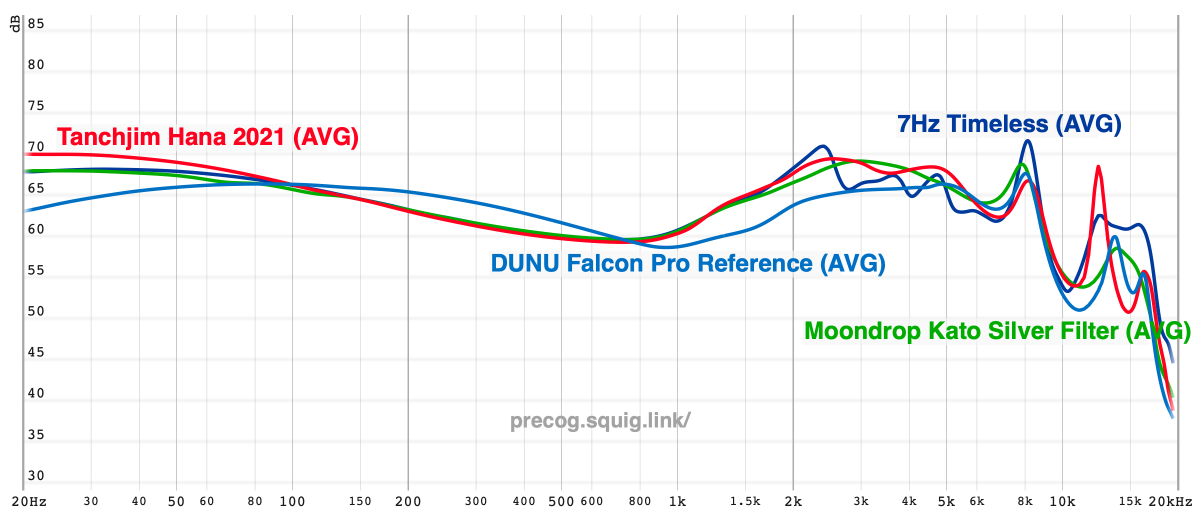
I think it’s safe to say that the Timeless at least competes with these IEMs. Perhaps not in terms of tuning - especially it comes to versus the Moondrop Kato and the Tanchjim Hana 2021 - but it definitely has a small technical edge over all three IEMs. The Timeless, then, is the IEM to buy if you’re indexing more heavily for an upfront, high-clarity sound. On the other hand, the Falcon Pro might be considered the antithesis of the Timeless. It has a considerably less clean presentation, yet its treble, imaging chops and timbre run laps around the Timeless for listeners who are after a more laidback, natural sound.
The Bottom Line
In my opinion, the 7Hz Timeless certainly merits some of the praise it's received. It’s probably the best planar IEM as a whole that I’ve heard to date (if you ignore DSP in the case of Audeze’s IEMs). You could even say it’s shifted the paradigm of the planar landscape and what we, as consumers, should expect from planar IEMs in the future. That in mind, I would give the Timeless a solid recommendation if you’re after the planar sound and the technical advantage it brings. But I also don’t think I'm entirely aboard the hype train. In the context of the broader market, it’s my opinion that there are IEMs such as the Tanchjim Hana 2021 and the Moondrop Kato that edge out the Timeless as a total package. An even better question might be whether the Timeless can “stand the test of time” as its name implies, especially considering I’ve already listened to another planar IEM with a near-identical frequency response to the Timeless. Perhaps the Timeless is just the spark for what we can expect in the future from this neglected (or rather, poorly implemented) IEM driver type.
Reference Tracks
- Aimer - Hakuchuumu
- David Nail - Let It Rain
- Everglow - DUN DUN
- Girls’ Generation - Galaxy Supernova
- Illenium - Broken Ones
- Joe Nichols - Sunny and 75
- Keith Urban - Defying Gravity (2009)
- Keiichi Okabe - Weight of the World (NieR:Automata Original Soundtrack)
- Sabai - Million Days
- Sawano Hiroyuki - Best of Vocal Works Remastered (2020)
- Taeyeon - My Voice (2017)
- Tiffany - I Just Wanna Dance
-Precogvision
